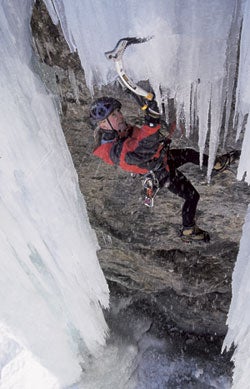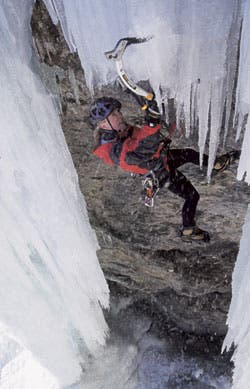Ice tool review - No 225 - November 2003

"Ice tool review - No 225 - November 2003"
Good tools and honed technique are key ingredients to ice-climbing success.Klaus Fengler

Swinging Solutions
10 technical tools put to the water-ice test
Last winter I tested 10 pairs of modern ice tools in flint-hard ice during a minus-30-degree cold snap in Quebec, during a minus-10-degree “heat-wave” in North Conway, and in almost slushy ice in Vail. In the end, I’m not sure which was abused more, the tools or me.
With its growing popularity, waterfall
ice climbing
has splintered like a chunk of ice into many sub-disciplines. You can climb long, wild waterfalls, dry-tool up routes that barely have any ice, or recreate in ice parks. The growth has also financed tremendous R&D by climbing manufacturers trying to create the perfect ice tool, and it’s obvious in this year’s stable of tools.
For me the most critical aspects of an ice tool’s design are how easy it is to place and remove, and how secure the pick is for hooking, dry-tooling, and planting in the ice. Beyond that, I like a comfortable leash that wraps securely around my wrist and a grip that feels good in my hand. Finally, I don’t want to sell my first-born to buy the tools — but once I’m on a hard lead I want good tools, no matter the cost.
The tools in this review are designed primarily for waterfall ice and mixed climbing. Some of them also work well on alpine ice or snow approaches and descents — important on some climbs — but for steep, hard climbing, you should be willing to sacrifice versatility for better performance on the ice.
When choosing your tools, it’s certainly helpful to attend an ice demo or festival where you can try out a variety of models. Bear in mind, however, that testing tools in the hacked-up ice typical at ice festivals or popular climbing areas does not render a full assessment of the tool’s performance. In fact, almost all of the tools reviewed here perform well in those conditions. If you will be climbing on steep, virgin ice in frigid conditions, it’s imperative that you test the tools in similar conditions.
One of the biggest challenges in comparing and evaluating ice tools is that each tool requires a slightly different swing to match the unit’s shaft curvature and pick droop. Add in the extreme variables of ice and it can take time to adapt your technique to an unfamiliar tool, which is why
ice climbers
often become loyal to a particular brand. Experiment with altering your swing by changing the speed and timing of the swing coming from your shoulder, your elbow, and your wrist — your goal is to land the pick straight in the ice.
The pick. The pick penetrates and connects your tool to the ice — it’s crucial to the tool’s performance. Fortunately, you can refine a pick’s shape with a few deft file strokes, converting even a mediocre pick into a brilliant performer. All the tools covered here have replaceable picks; filing your tools will require swapping in new picks on a regular basis.
A burly pick does not penetrate as easily and shatters more ice than a slender pick, but it’s less likely to break so it’s better for mixed climbing and climbers with an aggressive swing. A steeply drooped pick hooks better in pockets and old pick holes, but requires a sharp flick of the wrist at the end of the swing. A less drooped pick allows a more natural swing, but hooks less securely. I prefer more droop on steep ice, chandelier ice, and well-traveled, picked-out ice. Teeth near the shaft are always a plus because they grab the ice at the contact point when you’re hooking over ice bumps or cauliflowers.
The grip. The grip connects your hand to the tool, affecting your swing control and how pumped you get on steep terrain. The best grips for pure ice climbing feature an ergonomic shape that mates with your hand, and a high-friction texture so you don’t have to squeeze too hard. A pinky shelf just above the spike makes the tool easier to grasp on steep ice, but gets in the way if you’re trying to drive the shaft into hard snow (only two of the tools tested lack a pinky shelf). The grip should be small enough in circumference that you can easily control and hang from the tool.
The shaft. Modern ice tools have curved shafts that allow clearance between the pick and the shaft when planting the pick over bulges, or when hooking cauliflowers or hacked-up ice. Swinging a highly curved shaft requires practice. Well-designed shafts are made of aluminum or other lightweight material, which allows the weight to be concentrated in the head for better penetration.
The leash. A good leash is comfortable, secure on your wrist, and easy to get in and out of. A bad one can impede the circulation to your fingers, slip around on your wrist, or be difficult to put on and remove. Many leashes are detachable, so you can unclip them from the tool to free your hand when placing protection. A few of these clip onto a cable; they’re easy to operate but vibrate when you swing, which can make you wonder if your placement is shaky, or the pick loose. Other leashes do not detach, so you must let the tool dangle from your wrist while placing protection. This can be awkward, but it decreases your chance of accidentally dropping a tool. After-market leashes also are an option.
Spike, hammerhead, and adze. The spike is important for balancing with the tool when you’re moving on low-angle ice. A hammerhead allows you to pound pitons into the rock for protection, as well as drive-in ice pro including Snargs and Spectres. An adze can be helpful for chopping stances in alpine terrain, though it can also remove your lips if the tool pops in your face. I always climb with at least one hammerhead. and for pure ice climbing I prefer hammerheads on both tools.
Weight and balance. Smaller climbers or those with less arm strength often prefer lighter tools, as do those who climb with a very precise, technical style. Climbers with an aggressive swing often like the heft of a burly tool. More important than weight is balance. The tool’s balance point should be near its head so most of the energy of the swing goes into penetrating the ice. The listed weights include the leash.
The test resultsBlack Diamond Viper
C.A.M.P. TiburonCassin MirageCharlet Moser QuarkDMM XenoGrivel Tech WingHugh Banner SpitfireOmega Alpha TiStubai ScorpioTrango Madame Hook